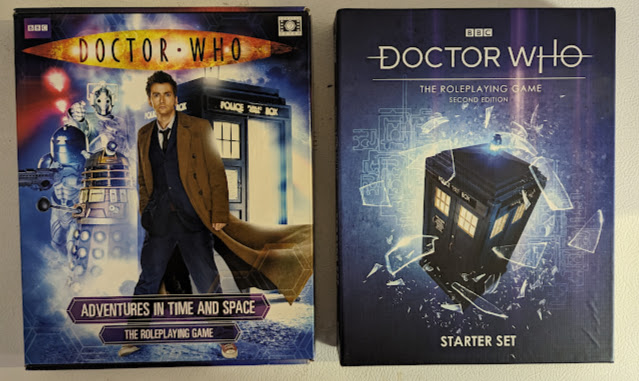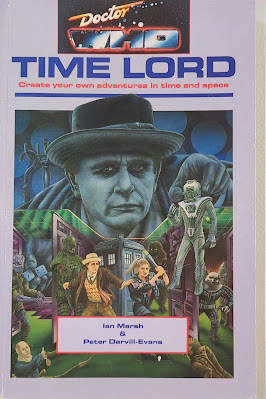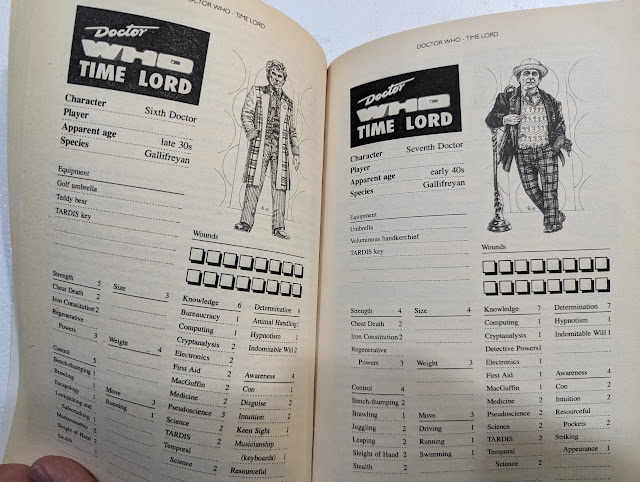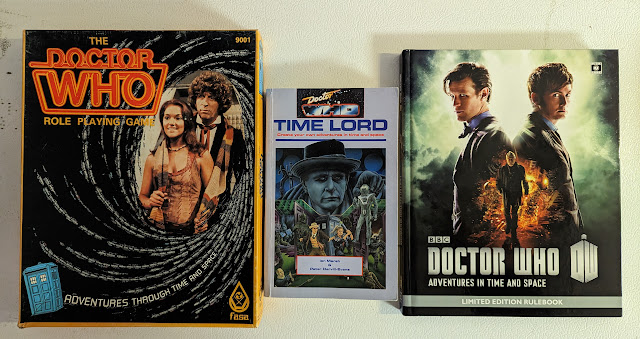
In almost forty years of
The Terminator films as a franchise and intellectual property, it is surprising to note that there has never been a roleplaying game based on them. After all, the concept is pretty simple—an unstoppable killing machine comes back from the future to kill the mother of the resistance leader who will defeat its A.I. master in the future—such that it is probably one of the easiest Science Fiction/horror time travel plots to adapt to the system of the Game Master’s choice. Yet still no roleplaying game when there have been two roleplaying games—one from Leading Edge Games and
another from Free League Publishing—based upon the
Alien franchise. Leading Edge Games did manage a set of miniatures wargaming rules,
TERMINATOR 2 Year of Darkness – Miniatures Combat System and several sets of miniatures, but not a roleplaying game. Fortunately, Scottish roleplaying publisher,
Nightfall Games, best known for the dystopian roleplaying game of corporate horror,
SLA Industries, gained the licence in 2020 and following a successful
Kickstarter campaign, published
The Terminator RPG and
The Terminator RPG Campaign Book, plus
The Terminator RPG Quick Start. One notable inclusion in the writing team for
The Terminator RPG is Andrew E.C. Gaska, the franchise consultant for 20th Century Studios on
Alien,
Predator, and
Planet of the Apes, who was also on the writing team for the
Alien: The Roleplaying Game.
The Terminator RPG is based upon
The Terminator, the original film by James Cameron from 1984 and then on the seventeen or so comic book storylines published by Dark Horse Comics between 1990 and 2019. The Science Fiction horror roleplaying game enables play in two time periods. The first is the future of the here and now, or at least an alternative here and now. This is the future of Judgement Day, in which the A.I. Skynet attempted to destroy its creators and the rest of humanity in nuclear, biological, and chemical conflagration before sending out increasingly sophisticated machines to wipe out humanity, whether through brute force or infiltration followed by brute force. The Resistance arose, led by those who had been preparing for Judgement Day and the rise of the robots, most notably, John Connor, to defeat Skynet and its forces. By the end of the 2020s, the Resistance would prevail, but not before Skynet developed temporal technology with Time Displacement Equipment, enabling it to send Terminator units back into the past and attack those who would become a danger to it in the future. Thus, the war against the machines became not a war of resistance and rebellion against Skynet, but a war through time, a hunt for Skynet’s agents across the later twentieth and early twenty-first centuries. This opens up the second time period, the 1980s, and whilst it would be possible to run campaigns in both periods without any crossover, travelling back from the 2020s opens up the possibility of some entertaining ‘fish out of water’ style roleplaying. In general, the emphasis in
The Terminator RPG is on the period of the 2020s, but there is still plenty of information about the 1980s to run a campaign set there.
A Resistance Fighter in
The Terminator RPG has a Role, such as Engineer, Hacker, or Scout. This provides a Resistance Fighter’s initial stats and a Resistance Ability. For example, the Grunt has ‘Physical Training’ which enables the Resistance Fighter to trade in a Skill die on a Strength or Dexterity related Skill Test and ensure that the result on the Success die is always a ‘Messy Success’ whatever is rolled. The Grunt also has extra Hit points. The Pilot, for example, has ‘Mechanised Warrior’, which enables the Pilot to control a vehicle passively and specialise in a particular type of vehicle. The Resistance Fighter has six stats—Strength, Dexterity, Knowledge, Concentration, Charisma, and Cool. Stats are rated between zero and six, whilst the skills are rated between one and four. A Resistance Fighter also has FATE, a replenishable representation of his luck, and he can have Traits, such as Addiction, Arrogant, Exceedingly Cool, or Vision (Good). He also has Hope Points, which are divided between three categories—Body, Brains, and Bravado—and indicate the ways in which a Resistance Fighter can emulate the cinematic style of
The Terminator. For example, with Body 2, Brains 3, and Bravado 1, Minguez the strategist could ‘Go Crashing In’ to dive into a room and gain a single charge or ranged action before combat begins, to make a ‘Luck Guess’ and gain a free bonus to a Knowledge or Concentration skill roll, or ‘Lead From The Front’ to lead soldiers into battle and bolster their morale. To create a character, a player selects a Role, assigns seven points to the stats, receives the base skill ranks for the Role and spends thirty-six points to purchase more skill ranks, and selects traits—both negative and positive so that they balance. A Resistance Fighter does not have to have any traits and there are relatively few of them, with fifteen negative traits versus only seven positive traits.
Name: David Renko
Role: Historian
STATS
Strength 1 Dexterity 1 Knowledge 5
Concentration 1 Charisma 2 Cool 1
FATE 1/1
HOPE
Brain 2 Bravado 1
Hit Points: 16 Willpower: 16
MOVEMENT
Closing: 2 Rushing 5 Encumbrance: 4 Initiative: 3
Resistance Ability: Natural Academic
SKILLS
Diplomacy 3, Education: Academic (Mathematics) 4, Education: Natural (Physics) 3, Endurance 1, Interrogate 1, Language: Russian 3, Lore: Skynet 3, Melee Weapons 1, Oratory 2, Pistol 1, Rifle 1, Stealth 1, Survival 1, Tactics 1, Time Science 1, Unarmed Combat 1
TRAITS
Anxiety (Rank 1), Natural Aptitude: Time Science (Rank 1)
The Terminator RPG allows for two further Resistance Fighter types. One is the Cyborg as per
Terminator 2: Judgement Day. There are no specific rules for creating this Resistance Fighter type, but guidelines suggest building it as a Grunt with the additional traits of ‘Learning to Run’, ‘All Hope is Gone’, and ‘Unstoppable’. The other is the Fated. They are NPCs or Resistance Fighters already known to Skynet (and so cannot have the associated negative trait) and worse, are in its crosshairs. The obvious character from
The Terminator for this is Sarah Connor.
Mechanically,
The Terminator RPG uses the ‘S5S’ System first seen in
SLA Industries, Second Edition. This is a dice pool system which uses ten-sided dice. The dice pool consists of one ten-sided die, called the Success Die, and Skill Dice equal to the skill being used, plus one. The Success Die should be of a different colour from the Skill Dice. The results of the dice roll are not added, but counted separately. Thus, to each roll is added the value of the Skill being rolled, plus its associated stat. If the result on the Success Die is equal to or greater than the Target Number, ranging from eight and Challenging to sixteen and Insane, then the Operative has succeeded. If the results of the Skill Dice also equal or exceed the Target Number, this improves the quality of the successful skill attempt. However, if the roll on the Success Die does not equal or exceed the Target Number, the attempt fails, even if multiple rolls on the Success Dice do. FATE can be spent to reroll the Success Die or any of the Skill Dice. It can also be spent to add a modifier to a Skill Test or a Resistance Test.
For example, David Renko is part of a resistance squad which has broken into a Skynet facility and discovered that it has Time Displacement Equipment or TDE. Unfortunately, the TDE was partially damaged in the assault on the facility and the date to when the Terminators have been sent back is not readily accessible. The resistance squad’s hacker has already managed to get the TDE computer working and Renko needs to determine the date from the accessible data. The Director—as the Game Master is known in
The Terminator RPG—sets the Difficulty of the Skill Test at Challenging or 11. Renko’s player assembles his dice pool. This consists of the Success Die plus a Skill Die for his Skill rank of one in Time Science plus an extra Skill Die. To the result of each die, Renko’s player will add the Skill rank of one in Time Science. Renko’s player rolls five on the Success Die, and three and five on the Skill dice. This a serious failure as none of the dice rolled a success. Renko’s player decides to use Renko’s of Natural Aptitude: Time Science, which at Rank 1, allows him a reroll in the skill. This time he rolls an eleven on the Success Die and a nine and a five on the Skill Dice. This is a Messy Success, which means that Renko can identify which year the Terminator units travelled back to, but no more. So, his player uses a point of FATE to reroll the Skill Dice. He rolls both of them and gets an eight and a ten. Adjusting the results with Renko’s Skill Rank of 1 in Time Science, the results are eleven on the Success Die and on one of the Skill Dice. This counts as a Solid Success and narrows the temporal destination for the Terminator down to a month.In terms of the rules,
The Terminator RPG runs implacably through the key elements of the setting, starting with combat. This is a major aspect of the setting so receives no little attention here, and is designed to be deadly, fraught, and highly tactical. It takes into account offensive and defensive manoeuvres, rate of fire, recoil, damage inflicted on armour, cover, aiming, and so on. Against ordinary opponents, combat is designed to be desperate and dangerous, but this only escalates when Terminator units become involved. As well as being physically dangerous, the unstoppably callous nature of Terminator units is extremely stressful and frightening, which can trigger Fear Tests, which typically occur when the Fear Rating of the situation is above a Resistance Fighter’s Cool stat. Failed Fear Tests lead to a loss of Willpower. As well as seeing a Terminator, being trapped or attacked, witnessing the brutality of Skynet, the loss of a close one, can all lead to Fear Tests if their Fear Rating is high enough. The rules also cover vehicle combat, traps, biological warfare and toxicants, and more, whilst the rules for traps cover disarming them as much as building them, so that the Resistance Fighters can lay traps as much as disarm them. Similarly, particular attention is paid to infiltration and exfiltration, as stealth is a key part to survival and moving around in the wasted world of the future as well as learning to get by in the bright and brazen world of the eighties.
Another major feature of
The Terminator RPG is Hacking. The rules cover hacking and computers in both the past and the future and the radical differences in terms of technology. One of the given Roles in the roleplaying game is the Hacker and he will primarily be hacking electronic devices and computer systems. In general, hacking small systems requires only a simple skill test, but for bigger systems and where it is narratively appropriate, the hacker can attempt to infiltrate a system consisting of a series of connected nodes represented by a ‘Network Architecture Diagrams’. The player rolls Computer skill tests to generate points of Progress which can be expended to move deeper into the network, create a backdoor, capture a node, exploit a subroutine. If alerted, Network Security, or ‘NetSec’, will spread through the system attempting to locate the hacker and halt his progress, the Director rolling for and handling this process. In effect, hacking is in effect a two-player mini-game between the Hacker’s player and the Director. Fortunately, it is intended to take place at the same pace as combat rounds do, so it can be run in parallel with them if need be. It needs careful study by both the Hacker’s player and the Game Master, and although there is an example hacking attempt given of the system included, it would be a good idea for the Director to run through this at least once to understand it before bringing it into play.
In terms of technology,
The Terminator RPG has lengthy sections devoted to both equipment and the machines of Skynet, the latter longer than the former. One nice touch is the equipment is organised not by name or type, but by the skill required to use each item, thus combining their description, the rules for their use, and their effects effectively under they are used. So, for example, dogs are listed under Animal Management, Time Displacement Equipment under Time Science, and everything from a flatbed truck to a main battle tank under Vehicles. Also covered are beam weapons, particle beam weapons, and other weapons deployed by Skynet. Then when it comes to the machines of
The Terminator setting,
The Terminator RPG covers much more than seen in the original film. So obviously the HK-Tank, HK-Drone, and T-800 Terminator, but
The Terminator RPG also draws deeply from the comic book series published by Dark Horse Comics. So there are basic T-000 models, humanoid Hunter-Killers, as well as T-700 or ‘Data Junkies’, which pose as the homeless and are sent back into the past to collect data and then hide until after Judgement Day; the T-K90 or ‘Labrador Deceivers’, which hide amongst the Resistance’s dogs and acclimatise them to the presence of metal; and even T-R80 or ‘Cyberbats’, used as reconnaissance units. This offers a wide variety of threats and suggests possible story ideas for the Director to use and develop. This is all backed up by the discussion of the various components, features, and design of Skynet’s machines, so that the Director can understand how they work. Unsurprisingly, there is a focus on the T-800 as seen in
The Terminator, including what happens when one loses various components. All of the machines given have game statistics as per a Resistance Fighter, but with high armour values and special rules which vary from model to model. Notable amongst the models are those developed by MIR, the Soviet Union’s answer to Skynet, which has an interesting relationship with its American counterpart.
In terms of background,
The Terminator RPG also explores the rapid technological progress of the late twentieth century which ultimately led to the development of Skynet. This includes other corporations which contributed technologies later incorporated by Skynet, giving the Resistance another set of targets in the past. Numerous NPCs, drawn from both film and comic, are also given, complete with full stats, starting with Sarah Connor and Kyle Reese in 1984, John Connor in 2029, Lieutenant Ed Traxler, LAPD, in 1984, and more. If there is a potential issue here is that a lot of these NPCs will be unfamiliar to the players and the Director—especially the Director, forcing her to scurry off in search of the Dark Horse Comics. A nice touch is that every NPC entry includes notes made by Doctor Peter Silberman, providing an often-deluded psychological profile for each person, as well as an assessment by Skynet itself. The Director gets to choose which of the two assessments is worse…
The Terminator RPG terminates with not one, but two missions for the Director to run. Neither is original. The first, ‘The Phone Book Killer’, is based on the story seen in The Terminator, whilst the second, ‘The Killer in Me’, is based on the graphic novel,
The Enemy Within. In both cases, the missions are designed to emulate rather than simulate the stories on which they are based. Thus in ‘The Phone Book Killer’, set in 1984, the Player Characters can be members of the LAPD investigating the case of the Sarah Connor murder spree or as Resistance Fighters sent back to stop the T-800. In the case of the latter, this will mean the players taking the roles of Sarah Connor and Kyle Reese, and essentially roleplaying the events out to see how they might differ, though there is scope for other Player Characters to get involved too. As a police investigation, the key Player Characters are Ed Traxler and Hal Vukovich, but again more Player Characters can be added, including Sarah Connor and Kyle Reese. Essentially, this is more of a toolkit to set up and explore the events of the story.
‘The Killer in Me’, the second mission is much more straightforward in its set-up and plot and is not the toolkit to set up and explore the events of its story that ‘The Phone Book Killer’ is. However, it does have the benefit of unfamiliarity, so the players and their Resistance Fighters can come to it unaware of its plot. Set in the 2020s, the Resistance Fighters are assigned to Lompoc Base, north of Los Angeles. The base is in danger of being overrun by Skynet, so when the base receives a message from a missing comrade that he has a cache of weapons and some survivors, both of which can help the base, its commander orders the Resistance Fighters to investigate. This requires a 150-mile trip, not through enemy territory, but under it via the sewerage tunnels. As the title of the mission suggests, this is a far more dangerous assignment than the Resistance Fighters will expect.
Physically,
The Terminator RPG is very well presented. It is well written, the artwork is really good—the depictions of the various NPCs look right and the Terminators look scary, and throughout, there are plenty of examples of the rules and suggestions for the Director.
If there are issues with
The Terminator RPG, they are relatively minor. For example, the list of Traits for Resistance Fighter creation seems paltry at best, and having ‘The Phone Book Killer’ as one of the two missions could also be seen as a cheap cop-out. Arguably, the former is more of an issue than the latter, limiting options in terms of Resistance Fighter creation, whereas the inclusion of
The Terminator storyline as a playable scenario lets you roleplay and explore a situation which many a gaming group has already done inspired by the events of the film already, but do it with proper guidance and advice on how to do it differently. The inclusion of ‘The Phone Book Killer’ essentially lets you roleplay a story or situation you have been waiting forty years to do and do it with the licenced roleplaying rules.
Perhaps more problematically, is the roleplaying game’s complexity.
The Terminator RPG looks complex and in some places it is. Then again, it has to be. This is roleplaying game and setting which involves near-unstoppable killing machines, which take tactics and ingenuity to destroy rather than brute force; computer systems which require infiltration against a faster, better, more capable enemy; and both desperation and courage. Yet,
The Terminator RPG is not overly complex by the standards of most roleplaying games, simply requiring patience to learn and get used to the mechanics. (As an aside, the most obvious licensee back in the day would have been Leading Edge Games, since it had the licence for the
TERMINATOR 2 Year of Darkness – Miniatures Combat System. However, it would have produced a roleplaying game based on
The Terminator akin to its
Aliens Adventure Game and that would have been complex. So, complexity is relative.
If there is a complex aspect of the roleplaying game, it is in the hacking rules, and that is to be expected. Hacking computers is not simple, especially if they are designed by an advanced A.I. Even then, the hacking rules are not that complex in comparison to other roleplaying games, but they do require attention and they do need to be learned how they work lest their inclusion slow play down.
Lastly, there is the issue of the source material for
The Terminator RPG. The original film is readily available. The comic books from Dark Horse Comics not so readily. The Director will probably need to track them down. The inclusion of a bibliography would have been useful to that end, let alone for reference. That is the single real omission
The Terminator RPG. However, the lack of relatively ready availability of the collected comics means that the Director’s players are unlikely to be as familiar with them and so she can easily plunder them for story ideas.
The Terminator RPG includes everything that a Director and her players need to run a game inspired by the original film—campaign ideas and advice, full stats and details on numerous killing machines, guidance on handling time travel, and fear in the face of the Terminators!
The Terminator RPG is the roleplaying game we have been waiting for, for almost four decades, enabling us to enter the future and past of James Cameron’s Science Fiction dystopia, overcome our fear in facing the Terminators and take the fight to Skynet.
 Name: The Terror in the TapestryPublisher: Chaosium, Inc.
Name: The Terror in the TapestryPublisher: Chaosium, Inc.




























